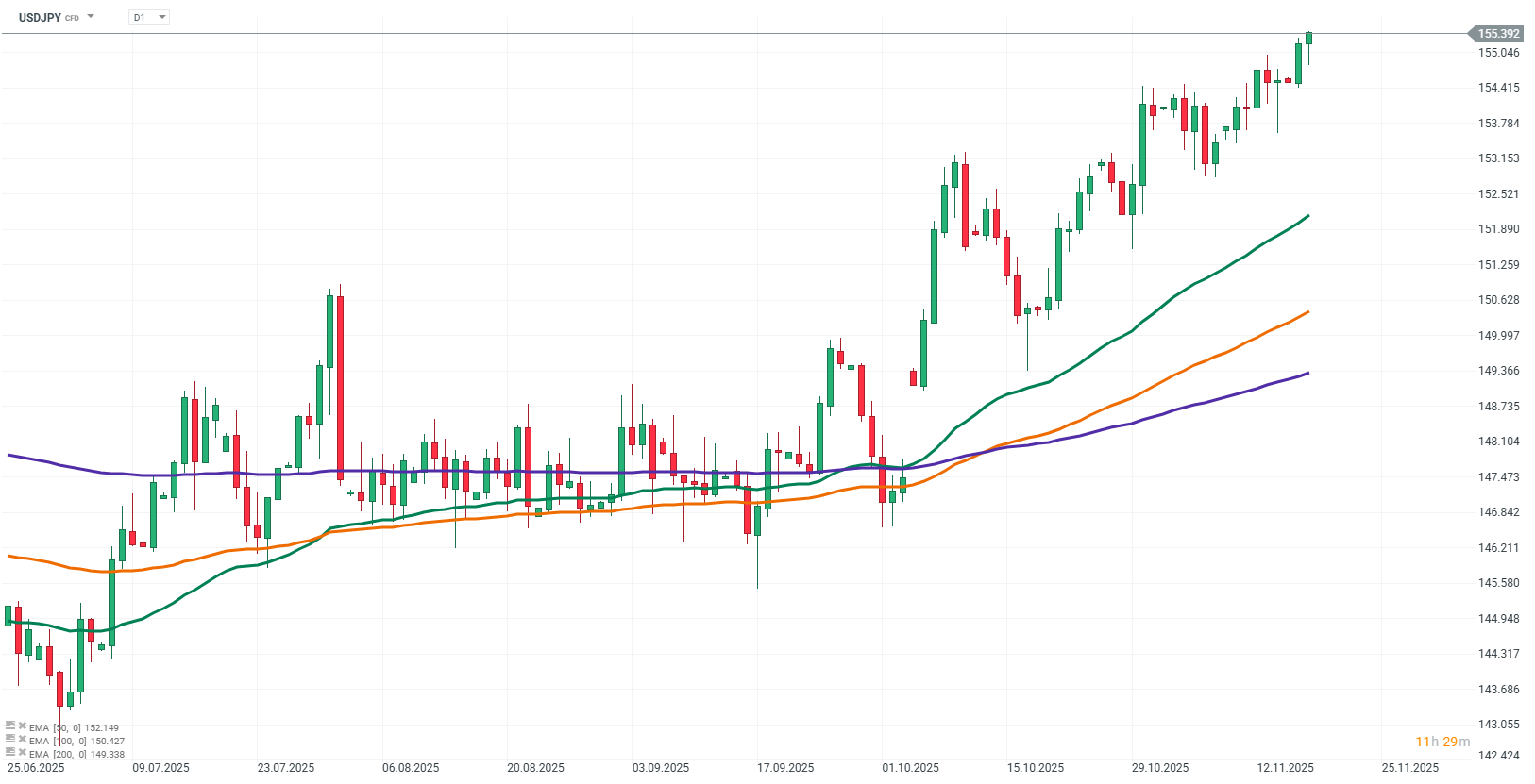The USD/JPY is currently trading around 155.40. Today’s movements remain clearly influenced by fundamental factors, with the balance of power between Japan and the United States still favoring the dollar. Despite the deterioration in global sentiment, markets are not turning to the yen, highlighting its structural weakness caused by the BOJ’s policy and the wide interest rate differential. Attention is also focused on domestic tensions in Japan, expectations regarding the Fed, and a set of upcoming US economic data that could determine the next moves for the pair.

What is driving USDJPY today?
Monetary policy of the Bank of Japan (BOJ)
The Bank of Japan continues its exceptionally accommodative monetary policy, keeping interest rates unchanged despite growing tensions within the Policy Board, where some members favored a hike. Markets do not expect tightening soon, as BOJ Governor Ueda signals that decisions may come only next year or even in 2026. Expectations for a December rate hike are very low, which keeps the yen widely used in funding strategies. This approach maintains persistent pressure on the Japanese currency.
Summary:
The BOJ remains very dovish, and markets do not expect near-term hikes. The US interest rate advantage remains strong, reinforcing the yen’s weakness.
Relations between the BOJ and the Japanese government
The government repeatedly stresses the need to stabilize the yen, but its interventions remain mostly verbal without concrete action. The BOJ is unwilling to adjust its policy solely to curb currency weakness, focusing instead on inflation and economic support. These differing priorities create clear tension between institutions, increasing market uncertainty. In this environment, Japan’s actions are seen as inconsistent, weakening confidence in the yen.
Summary:
The government talks about strengthening the yen but does not act decisively. The BOJ sticks to its strategy, creating tension. Markets interpret this as a sign of currency weakness.
Expectations regarding Fed policy
Markets are uncertain about the outcome of the Fed’s December meeting. The chances of a rate cut are limited, and the Fed emphasizes that decisions depend on incoming data, which stabilizes the dollar but does not give it a clear directional push. Compared with the BOJ’s dovish stance, this Fed neutrality favors the US currency.
Summary:
The Fed remains neutral, which is enough for the dollar to maintain its edge. Markets see a clear contrast with the dovish BOJ, supporting higher USD/JPY levels.
US and Japanese macroeconomic data
In the coming days, market attention will focus on releases such as ADP, the FOMC minutes, NFP, and inflation data from both the US and Japan. US data can strongly influence expectations for future Fed decisions, directly affecting USD/JPY. Stronger figures boost the dollar, while weaker ones may increase rate cut expectations and temporarily weaken USD. Japanese data have a smaller impact, as the BOJ reacts slowly.
Summary:
US data are the main driver of USD/JPY. Japanese data have little influence on the pair’s direction. Markets focus almost entirely on the US side.
Interest rate differential between the US and Japan
The wide gap between high US rates and very low Japanese rates remains a key factor in the yen’s structural weakness. This US advantage keeps yen funding attractive for markets, supporting capital flows into dollar-denominated assets. Even a global risk-off environment does not push markets back to the yen, as returns on US assets remain much higher. This phenomenon consistently weakens the Japanese currency.
Summary:
The large interest rate differential works against the yen. Markets continue to use it for funding, maintaining the dollar’s structural advantage.
Global situation and the current risk-off climate
The current deterioration in market sentiment is not leading to the typical strengthening of the yen, marking a notable shift from previous cycles. This results from the combination of very accommodative BOJ policy and a wide US rate advantage. In this environment, markets treat the dollar, US Treasuries, and the Swiss franc as safer assets than the yen. The yen’s traditional safe-haven role is clearly weakened by these structural factors.
Summary:
The current risk-off environment does not strengthen the yen, as markets choose other safe-haven assets. BOJ policy undermines its protective function.
AI Battle: Huawei vs Nvidia
Morning Wrap (18.11.2025)
Daily summary: Risk assets keep sliding on US rate cut jitters (17.11.2025)
Soybean at 15-month high on USDA report and US-China trade optimism 📈 🫛
The material on this page does not constitute as financial advice and does not take into account your level of understanding, investment objectives, financial situation or any other particular needs.
All the information provided, including opinions, market research, mathematical results and technical analyses published on the website or transmitted to you by other means is provided for information purposes only and should in no event be interpreted as an offer of, or solicitation for, a transaction in any financial instrument, nor should the information provided be construed as advice of legal or fiscal nature.
Any investment decisions you make shall be based exclusively on your level of understanding, investment objectives, financial situation or any other particular needs. Any decision to act on information published on the website or transmitted to you by other means is entirely at your own risk. You are solely responsible for such decisions.
If you are in doubt or are not sure that you understand a particular product, instrument, service, or transaction, you should seek professional or legal advice before trading.
Investing in OTC Derivatives carries a high degree of risk, as they are leveraged based products and often small movements in the market could lead to much larger movements in the value of your investment and this could work against you or for you. Please ensure that you fully understand the risks involved, taking into account your investments objectives and level of experience, before trading, and if necessary, seek independent advice.


